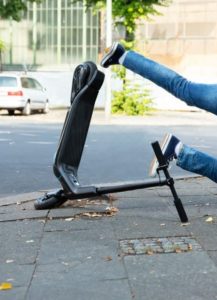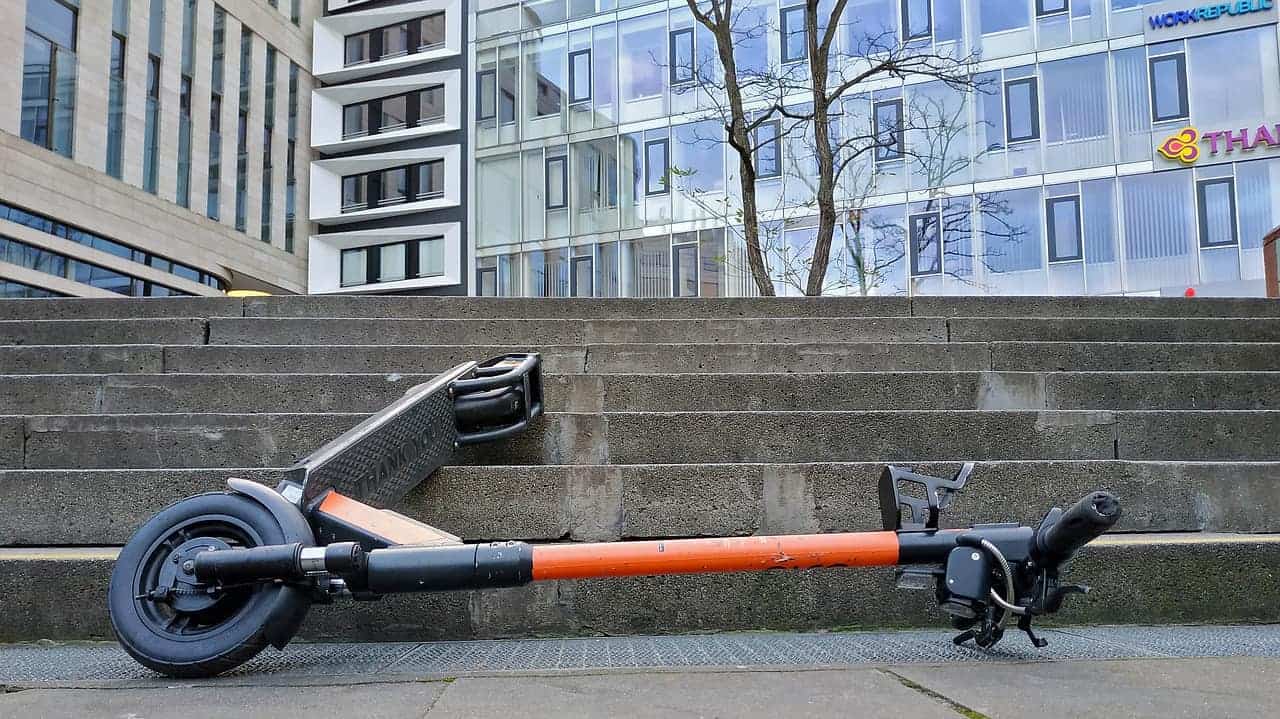Scooters have swept the world in a whirlwind of popularity. They have taken over the green transportation movement recently. Also, scooters have offered us a solution to short trips and last-mile transportation.
The question, however, is whether these scooters are a safe mode of transportation or not. There have been few studies conducted on scooter safety, but the ones that have been done all showed some reasonably consistent results.
So, let’s look at some problems and solutions for scooter safety and see what, if anything, can be done to make your next trip on a scooter a safer, more enjoyable journey.
What should I wear on a scooter?
Helmet

The critical safety aspect that many people overlook is helmet-wearing for scooter riding. According to emergency room reports in some cities, of those seen for scooter-related accidents and injuries, only 5% were wearing a helmet, which is an abysmal number considering that 19% were seen for head injuries. So, if you wish to remain safe while riding scooters, the first step is to wear your helmet. You have options when you only ride shared scooters like Byrd or Lime.
You can strap a helmet to your backpack before you leave home when you plan on
using one of these services, they have recently come out with foldable helmet designs. These newer foldable helmets protect your head just as well as the old style of hard-shell helmets, but they can easily fit in your bookbag, purse, or other daily worn bags. They have even begun research on helmets that can fit in your pocket, and hopefully, someday, those will become an option as studies predict that they could increase helmet wearing by as much as 15%.
knee and elbow pads
 More than head injuries, the most common injuries for scooter riders visiting an emergency room were upper extremity injuries, including bone fractures and ligament/tendon injuries. To avoid these, elbow and wrist pads are highly recommended, which is especially helpful for younger riders, specifically those 18 years old and under because they experienced approximately 60% of those injuries.
More than head injuries, the most common injuries for scooter riders visiting an emergency room were upper extremity injuries, including bone fractures and ligament/tendon injuries. To avoid these, elbow and wrist pads are highly recommended, which is especially helpful for younger riders, specifically those 18 years old and under because they experienced approximately 60% of those injuries.
For scooters with a seat, kneepads are recommended but not very necessary when looking at the statistics. Because very few injuries happened to the lower extremities (only about 9-11% depending on the study), a substantial portion was muscle injuries. A minute number of injuries were scrapes, cuts, or abrasions.
Kneepads may not save you from most leg injuries but are still on the list because they may help younger and more inexperienced riders avoid those common minor injuries. These are only injuries reported by emergency rooms, not a sample of everyone who got hurt on scooters. Many people have encountered minor wounds, abrasions, or road rash, and wearing knee pads can prevent many of those types.
Tips to stay safe on a scooter/ How to avoid crashes and injuries.
According to three studies that have been done on electric scooter programs and injuries in larger cities (Portland, OR, Los Angeles, CA, and Austin, TX), injuries happen about 20 times for every 100,000 miles. Realistically, this is a relatively safe number. In comparison, when it comes to the same statistic for bicycle riding, 36 injuries per 100,000 miles.
The problem is that 95% of those seeking treatment for scooter-related injuries were not wearing helmets, which correlates precisely with the previous emergency room report studies, which is alarming when as many as 15% encountered traumatic head injuries.
Experience
The most significant factor in scooter accidents is experience level: the most alarming statistic was that 30% of those who had to receive medical attention for scooter-related injuries were on their first trip on a scooter, and 60% had taken less than 10 total trips on a scooter.
The best advice for new scooter riders is to take it slow and first ride somewhere with little to no problematic features like traffic, pedestrians, wet ground, or rough terrain like gravel.
The best practice is on low-traffic streets or empty parking lots in your neighborhood. Once you have a little experience, you can move up to riding bike lanes on slow-speed limit roads.
Then, when you become experienced and comfortable with riding in these areas, you can move up to riding in traffic on those slower streets without bike lanes and practice riding within your city’s traffic laws. Finally, you should only move on to riding yourself in traffic on average-speed roads once you have plenty of practice and trust your abilities on a scooter.
The key to safe scooter riding is slowly working your way up to full-blown commuting on a scooter, as this will help you avoid becoming another one of these statistics. Starting too confidently and thinking you can ride with regular traffic right off the bat, like everyone else you may see cruising around town, can be considered foolhardy when you look at the statistics more closely.
Distracted Riding
 Some tips for safe riding start with: Do not ever operate your phone while riding. If you need to use your phone for navigation purposes, pull over briefly by coming to a complete stop from traffic on both the roads and sidewalks. You can then look at your phone while stopped, figure out where you need to go, and continue on your way.
Some tips for safe riding start with: Do not ever operate your phone while riding. If you need to use your phone for navigation purposes, pull over briefly by coming to a complete stop from traffic on both the roads and sidewalks. You can then look at your phone while stopped, figure out where you need to go, and continue on your way.
Of course, this is the safest way to manage that situation because those distracted while riding accounted for 42% of accidents. Still, this number included those listening to headphones while riding, meaning that setting aside that travel playlist while riding your scooter is the best idea. Not being able to hear cars approaching or passing or missing out on other warning sounds can put you in more danger than recommended or necessary.
Always hold on with both hands.
Riding one-handed is a big no-no. Riding with that cup of coffee or soda while gripping a grocery bag or having bags draped from the handlebars is extremely dangerous because it causes an imbalance in your riding. 68% of those seen for scooter accidents said they fell off their scooter in one way or another. So, not having an outstanding balance can quickly lead to one of these accidents, which can seriously hurt you. If you want to carry anything on a scooter trip, the recommended method is to wear a backpack. If you use your scooter to run to the grocery store, then bring an empty backpack and only buy as much as you can fit into it.
Ride Alone
You should never ride with passengers on your scooter. There is no dedicated room, and scooters were not designed for two people., exceeding the weight limit and putting you both in danger of equipment failure. Even parents with children should not be sharing a scooter. If your child is not old enough to handle a scooter on their own, then they should probably not be riding one in the first place.
One of the significant scooter program cities did a survey. The results showed that nearly 12% of riders were attempting to ride in tandem. This statistic is dangerous when you consider the consequences of doing so. Remember that when we talk about injury statistics, it only includes those seen at a medical facility for their injuries. Many more people are injured who do not go to the hospital or are only minorly hurt, but they still get hurt.
Equipment Check
Before you get on a scooter, always take a minute to inspect the scooter: check and make sure that the wheels are full of air if pneumatic or have no significant dents, missing chunks, or cracks if your wheels are solid. Ensure that lights are working, especially if you are in or will soon be in low light conditions, and ensure that your front and rear fender reflectors are securely attached.
Next, check to make sure any brake system is working correctly. Whether a rear fender step-down brake or a handbrake, ensure that it fully engages and isn’t loose. Finally, ensure that handlebars are secure, in the proper position for your height, and correctly aligned with the front wheel.
Doing a proper safety inspection before starting a ride can save you from any unexpected problems happening as you go down the road at speed, which could have disastrous consequences.
Which scooter tires are safer, small vs. big? Pneumatic vs. solid?
 When it comes to scooter tires, bigger tires are better than smaller ones because they absorb imperfections on the riding surface. Small cracks, bumps, and dips in the road are easier to pass over safely when you have bigger tires. Also, pneumatic tires can absorb these imperfections better than solid tires can. So, bigger pneumatic tires can handle less than ideal road conditions better than smaller solid tires, and if you have a choice in tires when picking out your scooter, then you should always keep this in mind.
When it comes to scooter tires, bigger tires are better than smaller ones because they absorb imperfections on the riding surface. Small cracks, bumps, and dips in the road are easier to pass over safely when you have bigger tires. Also, pneumatic tires can absorb these imperfections better than solid tires can. So, bigger pneumatic tires can handle less than ideal road conditions better than smaller solid tires, and if you have a choice in tires when picking out your scooter, then you should always keep this in mind.
The only downside to larger tires is that they may take more energy to keep moving, lowering your scooter’s distance per battery charge for electric-powered versions. However, they may be able to go faster, which can make up for the short discharge time but only for experienced riders who can handle themselves effectively at these faster paces.
Conclusion
Let’s look at some road safety tips to help you and your family arrive at your destination safely.
Here are the most valuable tips for s safe scooter ride.
1. WEAR A HELMET (head protection)
Wearing a helmet is one of the most important things you can do to protect yourself while riding an electric scooter.
Additionally, improvements in helmet design make them more comfortable and easier to wear. And if you’re wondering where you can find one that’s safe and stylish, here are some propositions:
2. DO NOT USE THE HEADPHONES
When navigating the street, it is best to pause the music and focus on your surroundings. For everyone’s safety, leave the headphones unplugged and keep your ears attentive to more essential sounds such as those emanating from cars, pedestrians, and other drivers.
3. SLOW DOWN
Whether you’re discovering a new part of your city or just commuting to your everyday destination, it’s easy to lose track of how fast you travel. Always remember that electric scooters can pick up speed more quickly than you think, significantly when assisted by the force of gravity. You need to verify the braking system of your scooter seriously.
If you are willing to buy y scooter, ask the seller questions about the type of brakes and verify that they are performant.
4. USE BICYCLE LANES
In cities where it is allowed, use the bike lane! They are generally installed in cities for cyclists who commute by bicycle, scooter, or other alternative transit modes. A quick search on the internet will show you bike paths, lanes, and other streets recommended for those traveling on two wheels.
5. FOLLOW THE TRAFFIC LAWS
The same traffic laws apply to an electric scooter as other vehicles. So be sure to respect the rules, including stopping at stop signs and traffic lights and following specific street speed limits.
6. Don’t drive while intoxicated
You should never, ever drink and drive. But there are many other ways to be drunk, and just because you haven’t had a drink doesn’t mean you can drive safely. Even being tired can affect your ability to react and make good decisions.
7. Pay attention
One of the essential road safety tips for everyone is to pay attention. Other drivers, cyclists, or walkers may do something unexpected on the road.
When you drive a car, you are in control of a powerful 3,000-pound object. You must pay full attention to your safety and the safety of everyone around you.
8. Avoid distractions
Texting or playing with your phone while driving is a big no-no. At the same time, it is common for people to have conversations while driving. Be careful not to become so engrossed in the conversation that you don’t pay attention.
9. Obey all signs and speed limits
Speed limits and other road guidelines exist for a reason. Not only will obeying traffic signs and speed limits allow you to drive as safely as possible, but you are also much less likely to get pulled over by the police.
When you think about it, there is very little reason to speed in the first place. You are putting yourself and others at risk, but you’re probably not going to save much time on travel time for most trips.
10. Avoid assumptions
Never assume what other drivers, cyclists, or pedestrians will do. Driving is an activity that can only be done when you are on your guard. Never believe that another driver will do what you think they should, and you should expect them to be unpredictable.
Always take driving seriously.
It is common to drive so often that it becomes something you don’t think about. It is essential always to remember that it is vital to take driving seriously and stay attentive. By familiarizing yourself with road safety tips, you will know how to drive safely.
